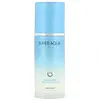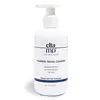What's inside
What's inside
 Key Ingredients
Key Ingredients

 Benefits
Benefits

 Concerns
Concerns

 Ingredients Side-by-side
Ingredients Side-by-side

Water
Skin ConditioningAmmonium Lauryl Sulfate
CleansingCocamidopropyl Betaine
CleansingAcrylates Copolymer
PEG-8
HumectantSodium Laureth Sulfate
CleansingCoco-Glucoside
CleansingMethyl Perfluorobutyl Ether
SolventMethyl Perfluoroisobutyl Ether
SolventPolyhydroxystearic Acid
EmulsifyingIsononyl Isononanoate
EmollientPhenoxyethanol
PreservativeTriethanolamine
BufferingSodium Cocamidopropyl Pg-Dimonium Chloride Phosphate
CleansingMethylparaben
PreservativeParfum
MaskingLilium Candidum Flower Extract
Skin ConditioningLuffa Cylindrica Fruit Extract
Skin ConditioningHedera Helix Extract
AntimicrobialDisodium EDTA
Gentiana Lutea Root Extract
Skin ConditioningAchillea Millefolium Extract
CleansingArtemisia Absinthium Extract
Skin ConditioningArnica Montana Flower Extract
MaskingSansevieria Trifasciata Leaf Extract
Skin ConditioningThymus Vulgaris Extract
PerfumingSodium Palmitoyl Proline
Skin ConditioningNymphaea Alba Flower Extract
Skin ConditioningSodium Hyaluronate
HumectantWater, Ammonium Lauryl Sulfate, Cocamidopropyl Betaine, Acrylates Copolymer, PEG-8, Sodium Laureth Sulfate, Coco-Glucoside, Methyl Perfluorobutyl Ether, Methyl Perfluoroisobutyl Ether, Polyhydroxystearic Acid, Isononyl Isononanoate, Phenoxyethanol, Triethanolamine, Sodium Cocamidopropyl Pg-Dimonium Chloride Phosphate, Methylparaben, Parfum, Lilium Candidum Flower Extract, Luffa Cylindrica Fruit Extract, Hedera Helix Extract, Disodium EDTA, Gentiana Lutea Root Extract, Achillea Millefolium Extract, Artemisia Absinthium Extract, Arnica Montana Flower Extract, Sansevieria Trifasciata Leaf Extract, Thymus Vulgaris Extract, Sodium Palmitoyl Proline, Nymphaea Alba Flower Extract, Sodium Hyaluronate
Water
Skin ConditioningSodium Cocoyl Glycinate
CleansingAcrylates Copolymer
Methyl Perfluoroisobutyl Ether
SolventMethyl Perfluorobutyl Ether
SolventMagnesium Silicate
AbsorbentSodium Cocoyl Apple Amino Acids
Skin ConditioningBromelain
Skin ConditioningPEG/PPG-14/4 Dimethicone
EmulsifyingPolyhydroxystearic Acid
EmulsifyingIsononyl Isononanoate
EmollientEthylhexyl Isononanoate
EmollientSodium Cocamidopropyl Pg-Dimonium Chloride Phosphate
CleansingPhenoxyethanol
PreservativeSodium Hydroxide
BufferingCapryloyl Glycine
CleansingUndecylenoyl Glycine
CleansingSodium Bisulfite
AntioxidantPropylene Glycol
HumectantMaltodextrin
AbsorbentCoconut Acid
CleansingSodium Chloride
MaskingHexylene Glycol
EmulsifyingTetrasodium Glutamate Diacetate
Parfum
MaskingWater, Sodium Cocoyl Glycinate, Acrylates Copolymer, Methyl Perfluoroisobutyl Ether, Methyl Perfluorobutyl Ether, Magnesium Silicate, Sodium Cocoyl Apple Amino Acids, Bromelain, PEG/PPG-14/4 Dimethicone, Polyhydroxystearic Acid, Isononyl Isononanoate, Ethylhexyl Isononanoate, Sodium Cocamidopropyl Pg-Dimonium Chloride Phosphate, Phenoxyethanol, Sodium Hydroxide, Capryloyl Glycine, Undecylenoyl Glycine, Sodium Bisulfite, Propylene Glycol, Maltodextrin, Coconut Acid, Sodium Chloride, Hexylene Glycol, Tetrasodium Glutamate Diacetate, Parfum
 Reviews
Reviews

Ingredients Explained
These ingredients are found in both products.
Ingredients higher up in an ingredient list are typically present in a larger amount.
Acrylates Copolymer is used as a film-forming agent and texture enhancer.
After applied, Acrylates Copolymer forms a thin film cover that helps skin feel more soft. It can help sunscreens become more water-resistant.
It is also used to make a product more thick.
Learn more about Acrylates CopolymerIsononyl Isononanoate is a synthetic skin-conditioner and texture enhancer. It is created from nonanoic acid, a fatty acid found in cocoa and lavender oil.
As an emollient, Isononyl Isononanoate helps keep your skin soft and smooth. This is because emollients create a barrier on the skin to trap moisture in.
Isononyl Isononanoate helps give products a velvet feel and improves spreadability.
Learn more about Isononyl IsononanoateWe don't have a description for Methyl Perfluorobutyl Ether yet.
We don't have a description for Methyl Perfluoroisobutyl Ether yet.
Parfum is a catch-all term for an ingredient or more that is used to give a scent to products.
Also called "fragrance", this ingredient can be a blend of hundreds of chemicals or plant oils. This means every product with "fragrance" or "parfum" in the ingredients list is a different mixture.
For instance, Habanolide is a proprietary trade name for a specific aroma chemical. When used as a fragrance ingredient in cosmetics, most aroma chemicals fall under the broad labeling category of “FRAGRANCE” or “PARFUM” according to EU and US regulations.
The term 'parfum' or 'fragrance' is not regulated in many countries. In many cases, it is up to the brand to define this term.
For instance, many brands choose to label themselves as "fragrance-free" because they are not using synthetic fragrances. However, their products may still contain ingredients such as essential oils that are considered a fragrance by INCI standards.
One example is Calendula flower extract. Calendula is an essential oil that still imparts a scent or 'fragrance'.
Depending on the blend, the ingredients in the mixture can cause allergies and sensitivities on the skin. Some ingredients that are known EU allergens include linalool and citronellol.
Parfum can also be used to mask or cover an unpleasant scent.
The bottom line is: not all fragrances/parfum/ingredients are created equally. If you are worried about fragrances, we recommend taking a closer look at an ingredient. And of course, we always recommend speaking with a professional.
Learn more about ParfumPhenoxyethanol is a preservative that has germicide, antimicrobial, and aromatic properties. Studies show that phenoxyethanol can prevent microbial growth. By itself, it has a scent that is similar to that of a rose.
It's often used in formulations along with Caprylyl Glycol to preserve the shelf life of products.
Polyhydroxystearic Acid is a soft wax made from castor oil.
It is is a texture thickener, emulsifier, and film-former. Emulsifiers prevent ingredients from separating, such as oils and waters.
Polyhydroxystearic Acid may not be fungal acne safe.
Learn more about Polyhydroxystearic AcidWe don't have a description for Sodium Cocamidopropyl Pg-Dimonium Chloride Phosphate yet.
Water. It's the most common cosmetic ingredient of all. You'll usually see it at the top of ingredient lists, meaning that it makes up the largest part of the product.
So why is it so popular? Water most often acts as a solvent - this means that it helps dissolve other ingredients into the formulation.
You'll also recognize water as that liquid we all need to stay alive. If you see this, drink a glass of water. Stay hydrated!
Learn more about Water